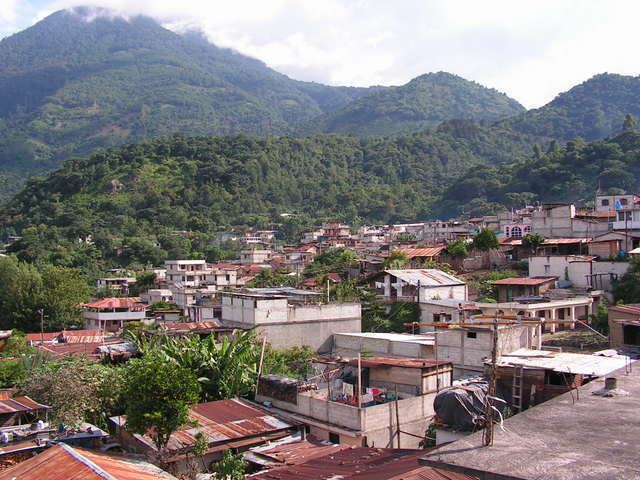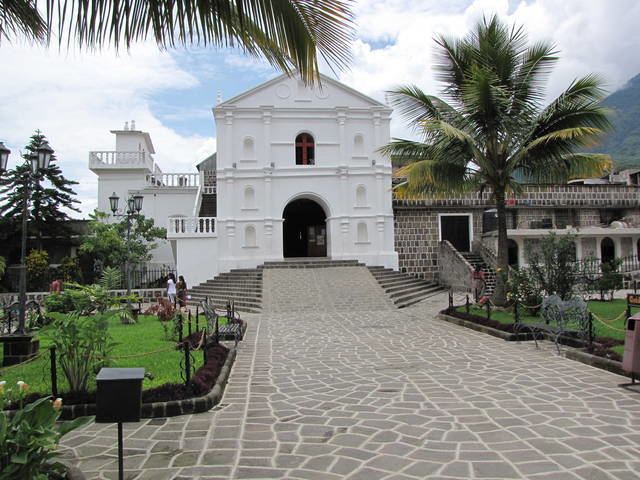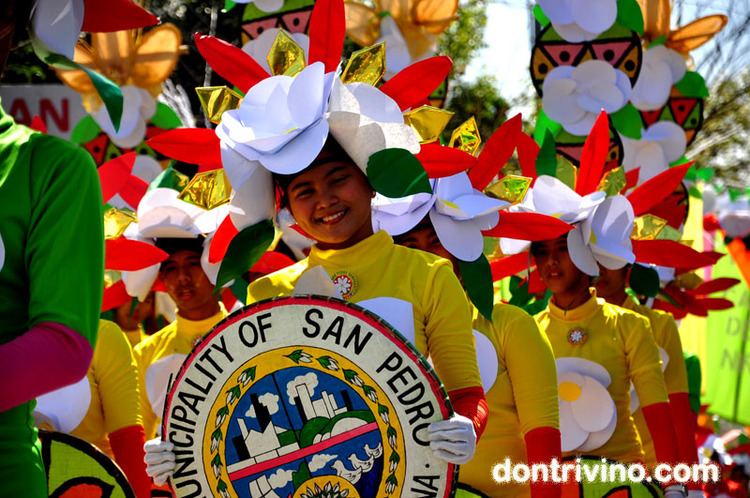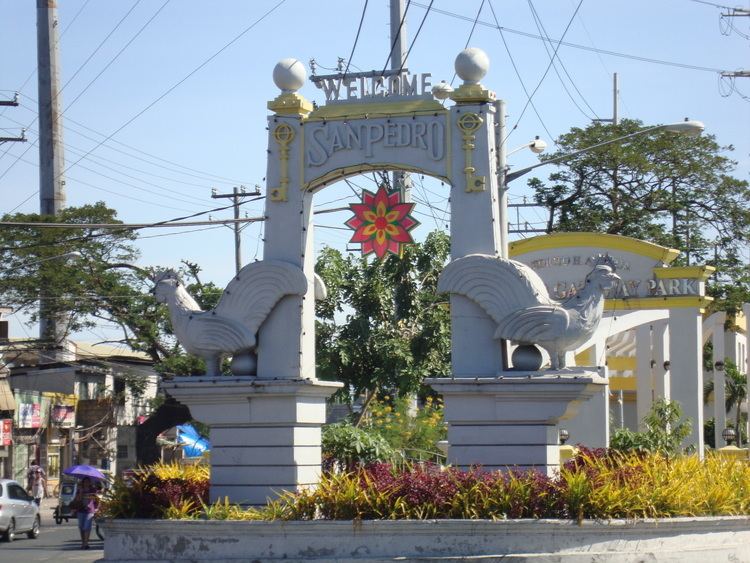Country Region Founded January 18, 1725 | Area 24.05 km2 District 1st district of Laguna Mayor Lourdes Cataquiz (NP) | |
 | ||
Similar Cabuyao, Laguna (province), Davao City | ||
Map of San Pedro, Laguna
San Pedro is a first class city in the province of Laguna, Philippines, officially City of San Pedro (Filipino: Lungsod ng San Pedro) and often referred to as San Pedro City. It is named after its patron saint, Peter the Apostle. According to the 2015 census, it has a population of 325,809 inhabitants. Despite being the third smallest in the entire Province, with a total land surface area of only 24.05 km2, San Pedro is the fourth largest city in terms of population after the cities of Calamba, Biñan, and Santa Rosa. The city also has the highest population density in the province of Laguna and in the whole Calabarzon Region, having 14,000 people/km2.
Contents
- Map of San Pedro Laguna
- San pedro la laguna tour guatemala
- We fall down by san lorenzo school san pedro laguna
- History
- Cityhood
- Geography
- Barangays
- Demographics
- Religion
- Economy
- Agriculture
- Commerce and industry
- Tourism
- Sampaguita Festival
- Christmas Festival
- Landmarks
- Transportation
- Public transport
- Roads
- Railway
- Healthcare
- Housing
- Education
- Notable people
- Twin towns sister cities
- References

San pedro la laguna tour guatemala
We fall down by san lorenzo school san pedro laguna
History

San Pedro de Tunasán became a town on January 18, 1725, when King Charles II of Spain decreed that the town formerly known as "Tabuko" be a separate town from "Kabullaw" (now known as the city of Cabuyao).

By virtue of the last will of Philip V of Spain, Rodriguez de Figueroa or "Don Esteban", a group of Augustinian Fathers gained the ownership of the Tunasán Estate. Later on, San Pedro became an hacienda of Colegio de San José, a group of Jesuits friars who took over the property which now is known as "San Pedro Tunasán". Tunasán literally means "a place where there is Tunás" (Nymphaea nouchali), a medicinal plant abundant on shoreline area.

During that period, agriculture, fishing, duck raising, fruit trees, and sampaguita were the main source of income of its residents. This period was highlighted by the growing tenant/landlord dispute. The tenants of Hacienda San Pedro Tunasán fought for their birthrights over their ancestral lands. This struggle took almost 423 years of unsuccessful resistance to Colegio de San José, and in 1938, the government bought the home sites of the San Pedro Tunasán Hacienda from the Colegio for re-sale to its tenants. This event laid to rest the tenants/landlord problem in the town.
In the year 1902, the name San Pedro de Tunasán was simplified to San Pedro.
From the Spanish time until after the Japanese occupation of the Philippines, the scenario did change a bit, when on August 30, 1954, beginning to the Philippine Commonwealth forces against the Japanese, President Ramón Magsaysay signed at the historic town plaza the Land Tenancy Act. By virtue of this law, farm lots of the hacienda were bought by the Philippine government to be sold at cost to the tenants or occupants of the farm lots in Bayan-Bayanan under the Narra Settlement Project of the Magsaysay Administration.
Cityhood
On March 27, 2013, President Benigno Aquino signed the 64-page Republic Act No. 10420 converting the municipality into a new component city of the province of Laguna. The cityhood of San Pedro was ratified through a plebiscite scheduled by the Commission on Elections (COMELEC). The date for the ratification is December 28, 2013 after the National Barangay Elections. It became the sixth city of Laguna after the cities of Biñan, Cabuyao, Calamba, San Pablo and Santa Rosa, and also the third to be a city in the 1st congressional district of Laguna - making it the first city district in the province.
COMELEC officially proclaimed the first-class municipality of San Pedro as a component city of Laguna on December 29, 2013. Juanito Icarro, regional director of Calabarzon and Mimaropa, and Marianne Marfori, provincial election supervisor, made the proclamation at the municipal hall after San Pedro residents voted for the cityhood in a plebiscite held on December 28, 2013. "Yes" votes for cityhood totaled 16,996 (which is an additional 50 votes added in some precincts mostly in the San Vicente area to win the "yes" vote), and "no" votes, only 869, in 501 clustered precincts in San Pedro. Only 11% of 165,777 registered voters in San Pedro's 20 barangays took part in the plebiscite.
Geography
San Pedro is located in Region 4A or Calabarzon. San Pedro is the boundary between Laguna and Metro Manila, so San Pedro is known as "Laguna's Gateway to Metro Manila". San Pedro shares boundaries with Metro Manila's southernmost city, Muntinlupa (north), Biñan (east), Dasmariñas (west), Carmona and Gen. Mariano Alvarez (southeast). Its position makes San Pedro a popular suburban residential community, where many residents commute daily to Metro Manila for work.
Barangays
San Pedro is politically subdivided into 27 barangays. Brgy. San Antonio is the largest barangay, which has a total of 780 hectares, while Brgy. San Vicente is the most populous with a total population of 92,092.
1 2 3 4 5 6 7^Seven new barangays created as separate and distinct from its mother Brgy. San Vicente after it was ratified and approved through a plebiscite held on July 11, 2015 under COMELEC Resolution No. 9969.
Demographics
The City of San Pedro is the 37th most populous city and youngest city in the Philippines. As of 2015, the population is 325,809, up from 294,310 in 2010, or an increase of almost 11%. Its area is 24.05 square kilometres (9.29 sq mi) with a density of 13,547/km2 (35,087/sq mi).
Religion
San Pedro is home for the Famous Krus ng San Pedro Tunasán. Majority of the people are Roman Catholics. Other religious groups include are the Members Church of God International (MCGI), Jesus Miracle Crusade International Ministry (JMCIM), United Church of Christ in the Philippines (UCCP), Jesus Is Lord Church (JIL), Jesus Christ the Lifegiver Ministries (JCLM), Iglesia Ni Cristo (INC), The United Methodist Church, Presbyterian Churches, Christian Bible Baptist Church, other Baptist and Bible Fundamental churches. Islam is also practiced within the community. There are 15 Catholic parishes in the city, and one mosque.
Economy
The largest barangay with industry, manufacturing, supermarkets, and stores in San Pedro is San Antonio. This barangay has the largest area in San Pedro. The city center and city proper or poblacion (San Pedro) is where most San Pedronians go to buy their goods. San Pedro also has a large number of factories surrounding it. Most of the factories are located at Magsaysay Road in San Antonio.
Agriculture
Agricultural lands now account for only thirteen hectares of the total land area due to residential, commercial and industrial conversions. There are lands with slope ranging from 8% - 15% of the total land area located in parts of Barangay San Antonio and San Vicente planted with mangoes and siniguelas trees. Livestock and poultry businesses operate in the area.
Commerce and industry
There are 4,705 total business establishments, 40 commercial, savings and rural banks, 117 restaurant, cafeteria, and other refreshment parlor, and two public and five private markets and supermarkets. There are 40 banks, 62 pawnshops, 36 lending institutions and 11 insurance companies operating in the city. A large percentage of industrial and manufacturing establishments of San Pedro is located on the adjacent barangays of San Vicente and San Antonio; E&E Industrial Complex is located in San Antonio where some of the city's factories are situated.
Tourism
City of San Pedro has a 20 km tourism belt to promote the hidden beauty of the city and to attract more tourists to the city.
Sampaguita Festival
The annual City Festival is celebrated in the second week of February. This week-long festival includes various activities ranging from cultural to sports, trade fairs, amateur singing contests, parades, historical exhibits, social and religious gatherings, tribal dances, street dances, cheering and sport exhibitions. The highlight of the festival is the coronation night of the "Hiyas ng San Pedro". The festival aims to promote tourism in San Pedro and to revitalize Sampaguita industry in the community.The celebration was formerly known as "Manok ni San Pedro Festival", which started in 1999 and was renamed to "Sampaguita Festival" in 2002. The celebration kicked off with a grand parade.
San Pedro City holds the record of laying the longest sampaguita (flower lei) line, spanning 3.6 km (2 mi), from Biñan City-San Pedro City boundary to San Pedro City-Muntinlupa City boundary on the National Highway; this was listed in the Guinness World Records in 2009.
Christmas Festival
Paskuhan Sa San Pedro is an annually celebrated festival in San Pedro City. It starts at the beginning of December and runs to the end of the month. The opening is a grand parade which is participated in by public and private schools in the city, local government and other socio-civic organizations. The main event of the opening is the lighting of the whole plaza, fireworks display, and various school performances. Every night a variety of shows are performed by the participants, which last up to midnight. On 29 December of every year the cityhood anniversary of San Pedro is celebrated.
Landmarks
The most popular landmarks in San Pedro include:
Transportation
In the city, jeepneys, tricycles, vans, and bus terminals provide transportation to every part of the city or outside city.
Public transport
Buses with lines from Metro Manila serve the city. Jeepneys provides service between the city and nearby areas and the city's barangays. Tricycles and pedicabs serves the barangays and subdivisions (gated communities).
Roads
The road network of San Pedro are mostly radial in nature, and relies on the National Highway (Daang Maharlika, or highway N1). The National Highway, which has been overtaken by the South Luzon Expressway (SLEX, or E2) in importance as the primary route to other parts of Laguna and southern Luzon, serves as the primary artery in the city, and jeepneys primarily use it. City roads radiate from the National Highway and the Poblacion area to connect the barangays, and some cross into boundaries with nearby cities and municipalities, like Muntinlupa, Biñan, and General Mariano Alvarez. The barangays are served by barangay roads, which complements the city roads.
South Luzon Expressway, numbered E2 and part of AH26, serves the city, with one exit, San Pedro Exit (Exit 27), and serves as the primary route through the area. Laguna Lakeshore Expressway Dike, a proposed expressway, will serve the city's eastern part.
Railway
Philippine National Railway Metro Commuter Line serves the city with two railroad stations:
Healthcare
Throughout the city, healthcare is primarily provided at the Barangay Health Centers in every barangay. Also, several medical missions are operated and provided by local and international organizations. The major hospitals in the city are:
Housing
In San Pedro, the population predominantly resides within more than 59 subdivisions, comprising both gated communities and open residential areas. Additionally, the city serves as the site for numerous relocation projects initiated by the government. Informal settlements, commonly referred to as squatter areas, are dispersed throughout San Pedro.
Education
The Department of Education Region IV-A - Division of San Pedro supervises the operation of over 12 public elementary schools and 7 public high schools, and provides permits to over 35 private schools, including Catholic schools. Private schools are scattered throughout the city, especially on the subdivisions. With the implementation of the K-12 program, some private schools added senior high schools, and many public high schools still have limited facilities for senior high school.
Tertiary education and technical education are provided by several institutions scattered on the city. The Laguna Northwestern College has two campuses in San Pedro, one being a branch on Pacita Complex. Polytechnic University of the Philippines has one campus in the city. San Pedro College of Business Administration in barangay Nueva provides courses related to business administration, and provides
Notable people
Twin towns – sister cities
San Pedro's sister city is Makati City. San Pedro is also twinned with Dupax del Norte, Nueva Vizcaya and Unisan, Quezon.
